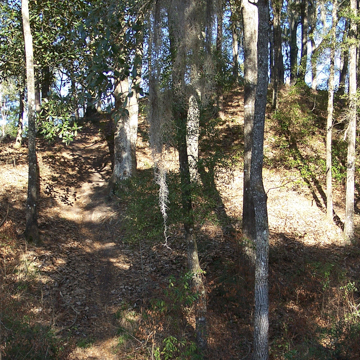Letchworth Mound, located in the Letchworth-Love Mounds Archaeological State Park and named after a former property owner, is the largest pre-Colombian earthwork in Florida and the second tallest pre-Colombian structure in Florida after the considerably younger Turtle Mound. Constructed between circa 200 and circa 800, by people of the so-called Weedon Island Culture, the site provides evidence of nearly 10,000 years of habitation.
According to reconstructions by Florida architect William N. Morgan and park officials, the earthwork consisted of a large structure defined by an irregular six-foot-high plinth orientated roughly north-south (tilted by about 12 degrees) that extended for 236 feet at its longest dimension. The plinth supported two large rectangular plazas: one oriented roughly east-west to the north, and a southern plaza oriented roughly north-south. An earthen pyramid, estimated to have risen as much as 46 feet above the plinth grade, sat between the two plazas and was connected to the north plaza by a ramp.
Located near the south end of Lake Miccosukee, the site contains more than twenty-eight mounds for either burials or housing. These have been found surrounding the raised plazas in an area that covers more than 190 acres. As reconstructed, the mounds to the south and east of the site were placed in rows that reinforced the orientation of the axes. This site is often compared in scale and grandeur to the Kolomoki Mounds in Georgia, which were built around the same time and also consisted of burial and ceremonial mounds around a considerably taller, fifty-seven-foot-high earthen pyramid.
In 1992, the State of Florida began to acquire much of this land, which was being used for agricultural purposes, including livestock production. Work began to preserve and document the mounds, and the state park opened to the public in 1998. Further research of the sited was conducted in 2003–2004 by the Bureau of Archaeological Research, who completed a survey of the park’s southern 40 acres, and in 2014 by a Florida State University field school.
References
Harper, Charlie, and Daniel M. Seinfeld. “Woodland Period Settlement Patterns at Letchworth Mounds (8JE337), Jefferson County, Florida.” Paper presented at the 81st Annual Meeting of the Society for American Archaeology, Orlando, Florida, 2016.
Florida Division of Recreation and Parks. Letchworth Mounds: Unit Management Plan. Tallahassee: Florida Division of Recreation and Parks, 2003.
Morgan, William N. Precolombian Architecture in Eastern North America. Gainesville: University Press of Florida, 1999.

